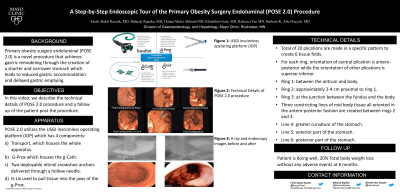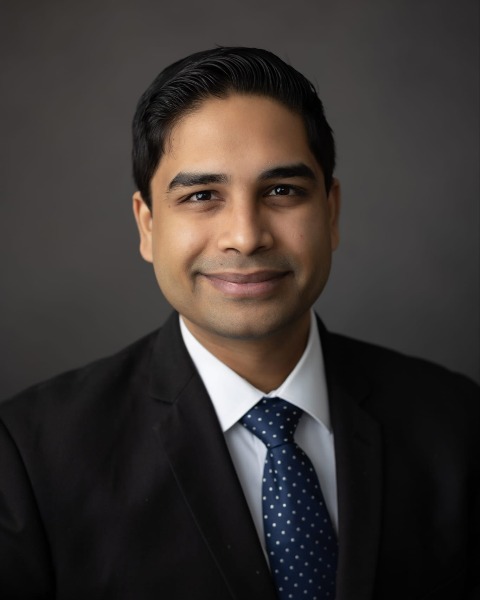Back


Poster Session E - Tuesday Afternoon
Category: Endoscopy Video Forum
E0182 - A Step-by-Step Endoscopic Tour of the Primary Obesity Surgery Endoluminal (POSE 2.0) Procedure
Tuesday, October 25, 2022
3:00 PM – 5:00 PM ET
Location: Crown Ballroom

Has Audio

Babusai Rapaka, MD
Mayo Clinic
Rochester, MN
Presenting Author(s)
Award: Presidential Poster Award
Farah Abdul Razzak, MD, Donna Maria Abboud, MD, Babusai Rapaka, MD, Khushboo S. Gala, MD, Rebecca Yao, MD, MPH, Barham Abu Dayyeh, MD, MPH
Mayo Clinic, Rochester, MN
Introduction: Endoscopic bariatric therapies (EBT) have emerged in the last two decades as safe and effective therapies for the management of obesity and its comorbidities. Primary obesity surgery endoluminal (POSE 2.0) procedure achieves gastric remodeling through the creation of a shorter and narrower stomach which leads to reduced gastric accommodation and delayed gastric emptying. In this video, we describe the technical details of POSE 2.0 procedure and a follow up of the patient post the procedure.
Case Description/Methods: POSE 2.0 utilizes the USGI incisionless operating platform (IOP) which has 4 components: a) the transport, which houses the whole apparatus, b) the g-Prox which houses the g-Cath (c) and two deployable nitinol snowshoe anchors delivered through a hollow needle and d) the g-Lix used to pull tissue into the jaws of the g-Prox. Plications are grasped with the g-Prox jaws. The force is distributed over the nitinol anchors to enhance the healing and durability. Theses plications result in serosa-serosa healing which can last up to 10 years. In total an average of 20 plications are created following a specific pattern to create six tissue folds or rings.
Three rings are created starting at the level of incisura. We use the helix for full thickness tissue acquisition, and each plication with these anchors creates a 6.5 cm reduction of the stomach. For each ring, the orientation of the central plication is antero-posterior to tubularize the stomach, while the orientation of other plications is superior inferior to shorten the stomach. Ring 1 is created at the junction between the antrum and body. In ring 1, five plications were created. Ring 2 is created approximately 2-4 cm proximal to ring 1. In ring 2, a total of five plications were created. Ring 3 is created at the junction between the fundus and the body. A total of five plications were created. Then, three constricting lines of mid body tissue all oriented in the antero-posterior fashion are created between rings 2 and 3. Line 4 is created at the greater curvature of the stomach where two plications were created. Line 5 is created at the anterior part of the stomach. One plication was created. Line 6 was created at the posterior part of the stomach. Two plications were created. The result is a narrow and tubularized stomach.
Discussion: The patient had no complications after the procedure. On four months follow up, the patient is doing well, has advanced her diet to solid food and has 20% total body weight lost.
Disclosures:
Farah Abdul Razzak, MD, Donna Maria Abboud, MD, Babusai Rapaka, MD, Khushboo S. Gala, MD, Rebecca Yao, MD, MPH, Barham Abu Dayyeh, MD, MPH. E0182 - A Step-by-Step Endoscopic Tour of the Primary Obesity Surgery Endoluminal (POSE 2.0) Procedure, ACG 2022 Annual Scientific Meeting Abstracts. Charlotte, NC: American College of Gastroenterology.
Farah Abdul Razzak, MD, Donna Maria Abboud, MD, Babusai Rapaka, MD, Khushboo S. Gala, MD, Rebecca Yao, MD, MPH, Barham Abu Dayyeh, MD, MPH
Mayo Clinic, Rochester, MN
Introduction: Endoscopic bariatric therapies (EBT) have emerged in the last two decades as safe and effective therapies for the management of obesity and its comorbidities. Primary obesity surgery endoluminal (POSE 2.0) procedure achieves gastric remodeling through the creation of a shorter and narrower stomach which leads to reduced gastric accommodation and delayed gastric emptying. In this video, we describe the technical details of POSE 2.0 procedure and a follow up of the patient post the procedure.
Case Description/Methods: POSE 2.0 utilizes the USGI incisionless operating platform (IOP) which has 4 components: a) the transport, which houses the whole apparatus, b) the g-Prox which houses the g-Cath (c) and two deployable nitinol snowshoe anchors delivered through a hollow needle and d) the g-Lix used to pull tissue into the jaws of the g-Prox. Plications are grasped with the g-Prox jaws. The force is distributed over the nitinol anchors to enhance the healing and durability. Theses plications result in serosa-serosa healing which can last up to 10 years. In total an average of 20 plications are created following a specific pattern to create six tissue folds or rings.
Three rings are created starting at the level of incisura. We use the helix for full thickness tissue acquisition, and each plication with these anchors creates a 6.5 cm reduction of the stomach. For each ring, the orientation of the central plication is antero-posterior to tubularize the stomach, while the orientation of other plications is superior inferior to shorten the stomach. Ring 1 is created at the junction between the antrum and body. In ring 1, five plications were created. Ring 2 is created approximately 2-4 cm proximal to ring 1. In ring 2, a total of five plications were created. Ring 3 is created at the junction between the fundus and the body. A total of five plications were created. Then, three constricting lines of mid body tissue all oriented in the antero-posterior fashion are created between rings 2 and 3. Line 4 is created at the greater curvature of the stomach where two plications were created. Line 5 is created at the anterior part of the stomach. One plication was created. Line 6 was created at the posterior part of the stomach. Two plications were created. The result is a narrow and tubularized stomach.
Discussion: The patient had no complications after the procedure. On four months follow up, the patient is doing well, has advanced her diet to solid food and has 20% total body weight lost.
Disclosures:
Farah Abdul Razzak indicated no relevant financial relationships.
Donna Maria Abboud indicated no relevant financial relationships.
Babusai Rapaka indicated no relevant financial relationships.
Khushboo Gala indicated no relevant financial relationships.
Rebecca Yao indicated no relevant financial relationships.
Barham Abu Dayyeh: Apollo Endosurgery – Grant/Research Support. Aspire Bariatrics – Grant/Research Support. BFKW – Consultant. Boston Scientific – Consultant, Grant/Research Support. Cairn Diagnostics – Grant/Research Support. DyaMx – Consultant. Endogastric Solutions, – Speakers Bureau. Endo-TAGSS – Consultant. GI Dynamics – Grant/Research Support. Johnson and Johnson – Speakers Bureau. Medtronic; – Grant/Research Support. Metamodix – Consultant. Olympus – Speakers Bureau. Spatz Medical – Grant/Research Support. USGI Medical – Consultant, Grant/Research Support.
Farah Abdul Razzak, MD, Donna Maria Abboud, MD, Babusai Rapaka, MD, Khushboo S. Gala, MD, Rebecca Yao, MD, MPH, Barham Abu Dayyeh, MD, MPH. E0182 - A Step-by-Step Endoscopic Tour of the Primary Obesity Surgery Endoluminal (POSE 2.0) Procedure, ACG 2022 Annual Scientific Meeting Abstracts. Charlotte, NC: American College of Gastroenterology.


